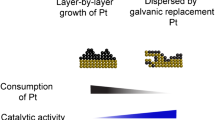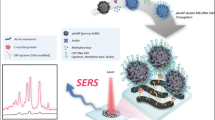Abstract
This study presents a promising approach for the one-pot generation of the biotin-derived gold nanoparticles (GNPs@biotin). We report a direct method for the reduction of tetrachloroauric acid with biotin and generation of the labels due to nets formed via biotin–streptavidin interactions. The synthesized GNPs@biotin have a characteristic plasmon maximum, excellent colloidal stability, and streptavidin coupling efficiency. The size of the GNPs@biotin:streptavidin nets and the efficiency of interaction with specific antibodies can be easily customized by the component concentrations and time of their interaction. Moreover, the proposed labels require no additional reagents or manipulations for the synthesis, separation, or purification. The developed labels were applied for the detection of the model antigen of C-reactive protein (CRP) as a major inflammation biomarker. The assembling labels demonstrated a competitive advantage limit of CRP detection (LOD) of 1.2 ng/mL and a limit of quantification (LOQ) of 3.9 ng/mL in human plasma comparable to classical immunoassays. Moreover, the proposed approach is universal and can be potentially applied for the quantitative determination of other biomarkers in a variety of immunoassays in a combination with specific biotinylated antibodies.
Graphical abstract






Similar content being viewed by others
References
Goryacheva IY, Lenain P, De Saeger S. Nanosized labels for rapid immunotests. TrAC - Trends Anal Chem. 2013;46:30–43. https://doi.org/10.1016/j.trac.2013.01.013.
Kokorina AA, Ponomaryova TS, Goryacheva IY. Photoluminescence-based immunochemical methods for determination of C-reactive protein and procalcitonin. Talanta. 2021;224:121837. https://doi.org/10.1016/j.talanta.2020.121837.
Han Y, Qiu C, Li J, Gao F, Yuan Q, Tang Y, Niu W, Wang X, Gao X, Gao L. Metal cluster-based electrochemical biosensing system for detecting epithelial-to-mesenchymal transition. ACS sensors. 2021;6:2290–8. https://doi.org/10.1021/acssensors.1c00339.
Gao L, Liu M, Ma G, Wang Y, Zhao L, Yuan Q, Gao F, Liu R, Zhai J, Chai Z, Zhao Y, Gao X. Peptide-conjugated gold Nanoprobe: intrinsic nanozyme-linked immunsorbant assay of integrin expression level on cell membrane. ACS Nano. 2015;9:10979–90. https://doi.org/10.1021/acsnano.5b04261.
António M, Nogueira J, Vitorino R, Daniel-da-silva AL. Functionalized gold nanoparticles for the detection of c-reactive protein. Nanomaterials. 2018;8:1–21. https://doi.org/10.3390/nano8040200.
Tabatabaei MS, Islam R, Ahmed M. Applications of gold nanoparticles in ELISA, PCR, and immuno-PCR assays: a review. Anal Chim Acta. 2021;1143:250–66. https://doi.org/10.1016/j.aca.2020.08.030.
Papavassiliou GC. Optical properties of small inorganic and organic metal particles. Prog Solid State Chem. 1979;12:185–271. https://doi.org/10.1016/0079-6786(79)90001-3.
Turkevich J, Stevenson PC, Hillier J. A study of the nucleation and growth processes in the synthesis of colloidal gold. Discuss Faraday Soc. 1951;11:55–75. https://doi.org/10.1039/DF9511100055.
Ma Z, Han H. One-step synthesis of cystine-coated gold nanoparticles in aqueous solution. Colloids Surfaces A Physicochem Eng Asp. 2008;317:229–33. https://doi.org/10.1016/j.colsurfa.2007.10.018.
Boca SC, Potara M, Toderas F, Stephan O, Baldeck PL, Astilean S. Uptake and biological effects of chitosan-capped gold nanoparticles on Chinese hamster ovary cells. Mater Sci Eng C. 2011;31:184–9. https://doi.org/10.1016/j.msec.2010.08.015.
Khan Z, Singh T, Hussain JI, Hashmi AA. Au(III)-CTAB reduction by ascorbic acid: preparation and characterization of gold nanoparticles. Colloids Surfaces B Biointerfaces. 2013;104:11–7. https://doi.org/10.1016/j.colsurfb.2012.11.017.
Ciganda R, Gu H, Hernandez R, Escobar A, Martínez A, Yates L, Moya S, Ruiz J, Astruc D. Electrostatic assembly of functional and macromolecular ferricinium chloride-stabilized gold nanoparticles. Inorg Chem. 2017;56:2784–91. https://doi.org/10.1021/acs.inorgchem.6b02850.
Brewer SH, Glomm WR, Johnson MC, Knag MK, Franzen S. Probing BSA binding to citrate-coated gold nanoparticles and surfaces. Langmuir. 2005;21:9303–7. https://doi.org/10.1021/la050588t.
Taranova NA, Urusov AE, Sadykhov EG, Zherdev AV, Dzantiev BB. Bifunctional gold nanoparticles as an agglomeration-enhancing tool for highly sensitive lateral flow tests: a case study with procalcitonin. Microchim Acta. 2017;184:4189–95. https://doi.org/10.1007/s00604-017-2355-4.
Jazayeri MH, Amani H, Pourfatollah AA, Pazoki-Toroudi H, Sedighimoghaddam B. Various methods of gold nanoparticles (GNPs) conjugation to antibodies. Sens Bio-Sens Res. 2016;9:17–22. https://doi.org/10.1016/j.sbsr.2016.04.002.
Beik J, Jafariyan M, Montazerabadi A, Ghadimi-Daresajini A, Tarighi P, Mahmoudabadi A, Ghaznavi H, Shakeri-Zadeh A. The benefits of folic acid-modified gold nanoparticles in CT-based molecular imaging: radiation dose reduction and image contrast enhancement. Artif Cells, Nanomed Biotechnol. 2018;46:1993–2001. https://doi.org/10.1080/21691401.2017.1408019.
Bartczak D, Kanaras AG. Preparation of peptide-functionalized gold nanoparticles using one pot EDC/Sulfo-NHS coupling. Langmuir. 2011;27:10119–23. https://doi.org/10.1021/la2022177.
Chirra HD, Sexton T, Biswal D, Hersh LB, Hilt JZ. Catalase-coupled gold nanoparticles: comparison between the carbodiimide and biotin-streptavidin methods. Acta Biomater. 2011;7:2865–72. https://doi.org/10.1016/j.actbio.2011.01.003.
Chivers CE, Koner AL, Lowe ED, Howarth M. How the biotin-streptavidin interaction was made even stronger: investigation via crystallography and a chimaeric tetramer. Biochem J. 2011;435:55–63. https://doi.org/10.1042/BJ20101593.
Sano T, Vajda S, Cantor CR. Genetic engineering of streptavidin, a versatile affinity tag. J Chromatogr B Biomed Appl. 1998;715:85–91. https://doi.org/10.1016/S0378-4347(98)00316-8.
Stayton PS, Freitag S, Klumb LA, Chilkoti A, Chu V, Penzotti JE, To R, Hyre D, Le Trong I, Lybrand TP, Stenkamp RE. Streptavidin-biotin binding energetics. Biomol Eng. 1999;16:39–44. https://doi.org/10.1016/S1050-3862(99)00042-X.
Aslan K, Luhrs CC, Pérez-Luna VH. Controlled and reversible aggregation of biotinylated gold nanoparticles with streptavidin. J Phys Chem B. 2004;108:15631–9. https://doi.org/10.1021/jp036089n.
Vásquez-Villanueva R, Peña-González CE, Sánchez-Nieves J, de la Mata FJ, Marina ML, García MC. Gold nanoparticles coated with carbosilane dendrons in protein sample preparation. Microchim Acta. 2019:186. https://doi.org/10.1007/s00604-019-3587-2.
Pearson TA, Mensah GA, Alexander RW, Anderson JL, Cannon RO, Criqui M, Fadl YY, Fortmann SP, Hong Y, Myers GL, Rifai N, Smith SC, Taubert K, Tracy RP, Vinicor F. Markers of inflammation and cardiovascular disease: application to clinical and public health practice: a statement for healthcare professionals from the centers for disease control and prevention and the American Heart Association. Circulation. 2003;107:499–511. https://doi.org/10.1161/01.CIR.0000052939.59093.45.
Ahn JS, Choi S, Jang SH, Chang HJ, Kim JH, Nahm KB, Oh SW, Choi EY. Development of a point-of-care assay system for high-sensitivity C-reactive protein in whole blood. Clin Chim Acta. 2003;332:51–9. https://doi.org/10.1016/S0009-8981(03)00113-X.
Cai Y, Kang K, Liu Y, Wang Y, He X. Development of a lateral flow immunoassay of C-reactive protein detection based on red fluorescent nanoparticles. Anal Biochem. 2018;556:129–35. https://doi.org/10.1016/j.ab.2018.06.017.
Huttunen RJ, Näreoja T, Mariani L, Härmä H. Residual nanoparticle label immunosensor for wash-free C-reactive protein detection in blood. Biosens Bioelectron. 2016;83:54–9. https://doi.org/10.1016/j.bios.2016.04.036.
Khuseyinova N, Imhof A, Trischler G, Rothenbacher D, Hutchinson WL, Pepys MB, Koenig W. Determination of C-reactive protein : comparison of three high-sensitivity immunoassays. Clin Chem. 2003;49:1691–5. https://doi.org/10.1373/49.10.1691.
Lv Y, Wang F, Li N, Wu R, Li J, Shen H, Li LS, Guo F. Development of dual quantum dots-based fluorescence-linked immunosorbent assay for simultaneous detection on inflammation biomarkers. Sensors Actuators B Chem. 2019;301:127118. https://doi.org/10.1016/j.snb.2019.127118.
Yeh ETH, Willerson JT. Coming of age of C-reactive protein: using inflammation markers in cardiology. Circulation. 2003;107:370–2. https://doi.org/10.1161/01.CIR.0000053731.05365.5A.
Kim WJ, Cho HY, Jeong B, Byun S, Huh JD, Kim YJ (2018) Synergistic use of gold nanoparticles (AuNPs) and “capillary enzyme-linked immunosorbent assay (ELISA)” for high sensitivity and fast assays. Sensors (Switzerland) 18: . https://doi.org/10.3390/s18010055.
Lv Y, Li J, Wu R, Wang G, Wu M, Shen H, Li LS. Silica-encapsulated quantum dots for highly efficient and stable fluorescence immunoassay of C-reactive protein. Biochem Eng J. 2018;137:344–51. https://doi.org/10.1016/j.bej.2018.06.016.
Sobolev AM, Byzova NA, Goryacheva IY, Zherdev AV. Silanized quantum dots as labels in lateral flow test strips for C-reactive protein. Anal Lett. 2019;52:1874–87. https://doi.org/10.1080/00032719.2019.1574302.
Oh YK, Joung HA, Han HS, Suk HJ, Kim MG. A three-line lateral flow assay strip for the measurement of C-reactive protein covering a broad physiological concentration range in human sera. Biosens Bioelectron. 2014;61:285–9. https://doi.org/10.1016/j.bios.2014.04.032.
Haiss W, Thanh N, Aveyard J, Fernig DG. Determination of size and concentration of gold nanoparticles from UV-vis spectra. Anal Chem. 2007;79:4215–21.
Frens G. Controlled nucleation for the regulation of the particle size in monodisperse gold suspensions. Nat Phys Sci. 1973;241:20–2.
Zhu X, Chen L, Shen P, Jia J, Zhang D, Yang L. High sensitive detection of Cry1Ab protein using a quantum dot-based fluorescence-linked immunosorbent assay. J Agric Food Chem. 2011;59:2184–9. https://doi.org/10.1021/jf104140t.
Leff DV, Brandt L, Heath JR. Synthesis and characterization of hydrophobic, organically-soluble gold nanocrystals functionalized with primary amines. Langmuir. 1996;12:4723–30. https://doi.org/10.1021/la960445u.
Weber PC, Ohlendorf, D. H., Wendoloski, J. J., Salemme FR (1989) Structural origins of high-affinity biotin binding to streptavidin. Science (80- ) 243:85–88.
Kokorina AA, Bakal AA, Shpuntova DV, Kostritskiy AY, Beloglazova NV, De Saeger S, Sukhorukov GB, Sapelkin AV, Goryacheva IY. Gel electrophoresis separation and origins of light emission in fluorophores prepared from citric acid and ethylenediamine. Sci Rep. 2019;9:1–8. https://doi.org/10.1038/s41598-019-50922-6.
Basu S, Ghosh SK, Kundu S, Panigrahi S, Praharaj S, Pande S, Jana S, Pal T. Biomolecule induced nanoparticle aggregation: effect of particle size on interparticle coupling. J Colloid Interface Sci. 2007;313:724–34. https://doi.org/10.1016/j.jcis.2007.04.069.
Crowther J (2009) The ELISA guidebook.
Nguyen DT, Kim DJ, So MG, Kim KS. Experimental measurements of gold nanoparticle nucleation and growth by citrate reduction of HAuCl4. Adv Powder Technol. 2010;21:111–8. https://doi.org/10.1016/j.apt.2009.11.005.
Acknowledgements
The reported study was funded by the Russian Science Foundation (project number 20-13-00195). Alina A. Kokorina thanks the Russian Foundation for Basic Research (project number 19-33-90159) for individual support. The authors gratefully acknowledge Andrey M. Burov of the Institute of Biochemistry and Physiology of Plants and Microorganisms Russian Academy of Sciences.
Author information
Authors and Affiliations
Corresponding author
Ethics declarations
Conflict of interest
The authors declare no competing interests.
The research volunteer blood plasma was used for the experiments of C-reactive protein determination. Protocol № 8 from 02.03.2021, Saratov State Medical University named after V.I. Razumovsky.
Additional information
Publisher’s note
Springer Nature remains neutral with regard to jurisdictional claims in published maps and institutional affiliations.
Supplementary information
ESM 1
(DOCX 8357 kb)
Rights and permissions
About this article
Cite this article
Kokorina, A.A., Rashchevskaya, R.O. & Goryacheva, I.Y. Nets of biotin-derived gold nanoparticles as a label for the C-reactive protein immunoassay. Anal Bioanal Chem 413, 6867–6875 (2021). https://doi.org/10.1007/s00216-021-03645-5
Received:
Revised:
Accepted:
Published:
Issue Date:
DOI: https://doi.org/10.1007/s00216-021-03645-5




